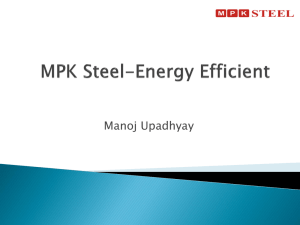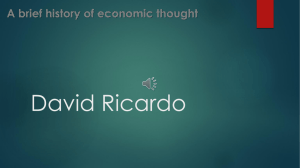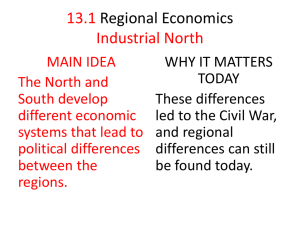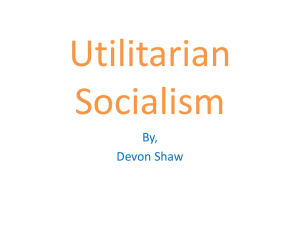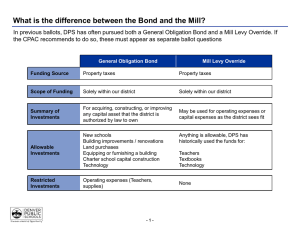Chapter 6 - J.S. Mill
advertisement
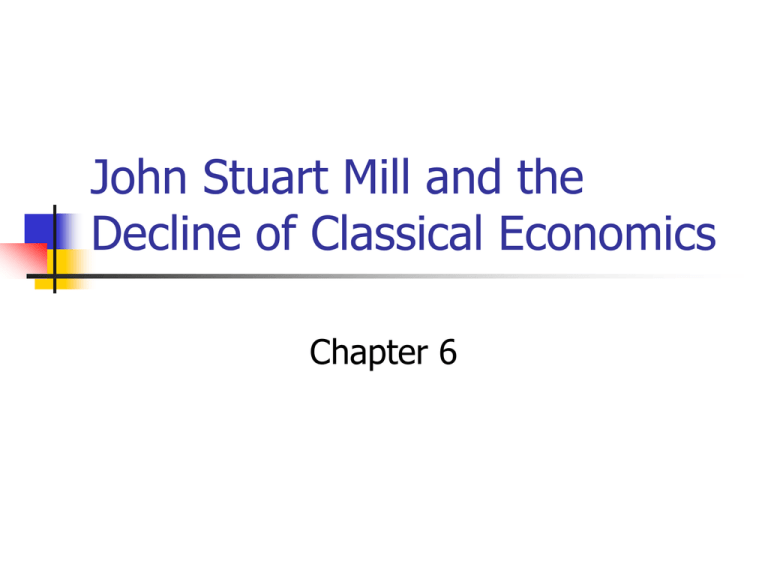
John Stuart Mill and the Decline of Classical Economics Chapter 6 John Stuart Mill He was Jeremy Bentham’s godson Educated by his father (a Ricardian economist), who hoped to create a genius intellect who would carry on the cause of utilitarianism He succeeded At age 21 Mill suffered a nervous breakdown, in part due to the stress imposed by his father Some say he was the greatest 19th century British philosopher John Stuart Mill Attempted to rescue Ricardo’s theories which were under attack He revised Ricardo’s classical theory Attacks on Ricardo Disparity between Ricardo’s theory and empirical evidence (reality) Malthusian Population Doctrine not supported by empirical evidence - real per capital income was increasing Diminishing returns to agriculture – technological progress increased returns Profits were not decreasing Landlords were not becoming richer Attacks on Ricardo Criticism from “professional” economists who attacked his theoretical structure They attacked labor theory of value Did not like the fact that he ignored profits as price determining Attacks on Ricardo Criticism from humanist and socialist writers These writers pointed to the negative aspects of capitalism – viewed it as “disharmonious” There is not universal agreement among these writers as to solutions to this disharmony Some advocated more income to workers, especially if labor theory of value is true Some wanted a return to the past, with production centered with artisans and craftsmen Some wanted more state planning Defenders of Ricardo Nassau Senior - MAYBE Senior stated that economics should focus on developing internally consistent theories rather than worry about empirical foundations; that is, conclusions should follow from assumptions, even if the assumptions were not grounded in empirical fact Essence of Mill’s Theory Utilitarianism Maximization of good over bad – greatest happiness principle “actions are right in proportion as they tend to promote happiness; wrong as they tend to produce the reverse of happiness. By happiness is intended pleasure and the absence of pain; by unhappiness, pain and the privation of pleasure.” Essence of Mill’s Theory Libertarian – On Liberty people can do anything they like as long as it does not harm others Moral and economic liberty Free markets He believed that freedom would lead to the best possible outcome for society Essence of Mill’s Theory Advocates and critics of Mill's views have argued that he does not take liberty as an absolute standard of value, and believed that diversity, equality and social progress are more important goals than liberty He was interested in redistribution of income in order to achieve best possible outcome – the greatest happiness Framework of Analysis What are the questions that J.S. Mill is asking? How can classical economic theory be saved? What modifications need to be made to classical theory? Framework of Analysis What are Mills’ assumptions? Theory should reflect reality – empiricism Utility maximization Framework of Analysis What is the economic/political / cultural/social environment of Mill? Rise of socialists – critics of capitalism and capitalists Framework of Analysis What is the role of the market? Advocated economic liberty and free markets BUT, remember be was a utilitarian and he understood that free markets do not always maximize social good Framework of Analysis What is the role of government? Middle ground between laissez-faire capitalism and socialism General rule was that government should prevent people from harming others He discussed class conflict between landlords and others in society but did not emphasize class conflict between capitalists and workers Advocated public education, labor unions, inheritance taxes, shorter work day Framework of Analysis What is the role of government? In general, he accepted government interventions in the economy if there were sufficient utilitarian grounds Mill believed that "equality of taxation" meant "equality of sacrifice" and that progressive taxation penalized those who worked harder and saved more and was therefore "a mild form of robbery". How did Mill's approach to economics differ from others in the classical school? Believed that conclusions drawn from deductive economic models should be tested to see if they correspond to reality (although he did not always do this) Mill was more "Smithian" than "Ricardian" - he thought that economics should be integrated into broader theories of human behavior He distinguished between laws of production and laws of distribution laws of production are laws of nature, cannot be changed by people laws of distribution were based on human action and institutions - these can be changed by social intervention How was J.S. Mill influenced by the ideas of Jeremy Bentham? Bentham was a utilitarian - achieve pleasure and avoid pain 'utility' being defined as pleasure, preference-satisfaction, or in reference to an objective list of values (remember the concept of utility maximization from EC215?) He left a large estate, which was used to finance University College, London (for those individuals excluded from university education--i.e., non-conformists, Catholics and Jews) as an interesting note, after his death his body, per his instructions, was dissected, embalmed, dressed, and placed in a chair, and to this day resides in a cabinet in a corridor of the main building of University College Bentham hoped to based social reform on measured utility that would lead to "greatest good for the greatest number" How was J.S. Mill influenced by the ideas of Jeremy Bentham? Bentham's focus on social reform which was of interest to J.S. Mill, but Mill did not agree with Bentham on all matters Bentham treats all forms of happiness as equal, whereas Mill argues that intellectual and moral pleasures are superior to more physical forms of pleasure. Mill not believe in the dogmatic view that pain/pleasure was the only way to analyze human behavior How did Mill view the long run state of a capitalist economy? Adhered to Ricardo's prediction of long run decline in rate of profit and a stationary state But he was not sure that this was necessarily bad, considering the terrible conditions in which so many people lived during the industrial revolution - he thought that less focus on economic growth might be a good thing, change in focus of values He would have preferred a reduction in the rate of population growth in order for people to have a higher standard of living How does Mill's view of the role of theory in economics differ from that of Ricardo? Abstract economic theory should be examined in light of reality He believed that classicals focused too much on competition and ignored the role of custom in determining the distribution of income Mill believed that economics should be more integrated with a comprehensive study of human behavior How did Mill's theory of value compare to that of Ricardo? Prices are determined through the interaction of Demand (utility) and Supply (difficulty of attainment) In some markets, supply is perfectly inelastic – rare commodities. Also used this model to analyze monopolies, in which the producer can restrict production How did Mill's theory of value compare to that of Ricardo? In some markets (manufactured goods) supply is perfectly elastic (constant cost industries) so that prices are determined by costs of production In agricultural markets (increasing cost industries) the supply curve is upward sloping How did Mill's theory of value compare to that of Ricardo? So, like Ricardo, he did assume diminishing returns in agriculture but not in manufacturing How did Mill's theory of value differ from that of Ricardo? Rejected Ricardo's labor theory of value – looked at all costs of production in determining price He saw rent as price determining (not price determined like Ricardo) when land has alternative uses How did Mill expand and improve the theory of comparative advantage? Ricardo's model showed the limits to the terms of trade Mill showed how the actual terms of trade could be determined using concept of demand He also introduced transportation costs into the model and discussed how tariffs will influence the terms of trade (international prices) How did Mill defend Say's Law? Discussed three types of economies - barter, money with no credit (commodity money) and money with credit In barter economy or commodity money economy there will be no oversupply - production will only take place when there is a desire for other goods But in an economy with credit, then money can be saved (store of value) and may not be spent in the current period but the oversupply will be purchased later as prices adjust to clear the markets How did Mill attempt to modify the wages fund doctrine? There is a maximum wages fund BUT The existing labor force may not exhaust this fund AND SO Labor unions could help workers increase the wage rate So what were the major modifications that Mill made to classical economics?

